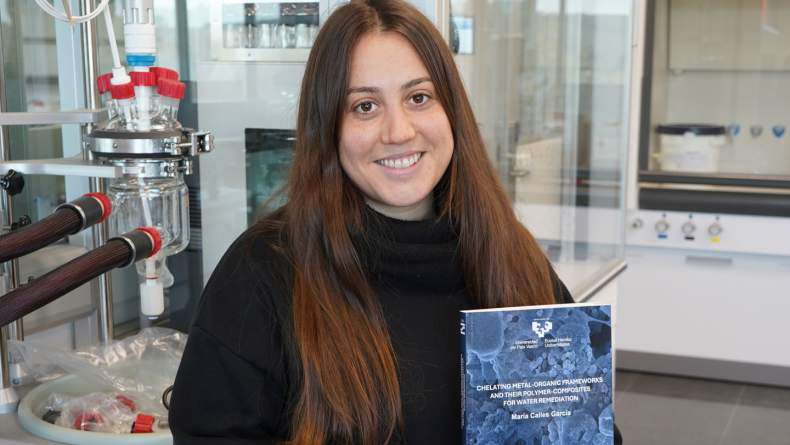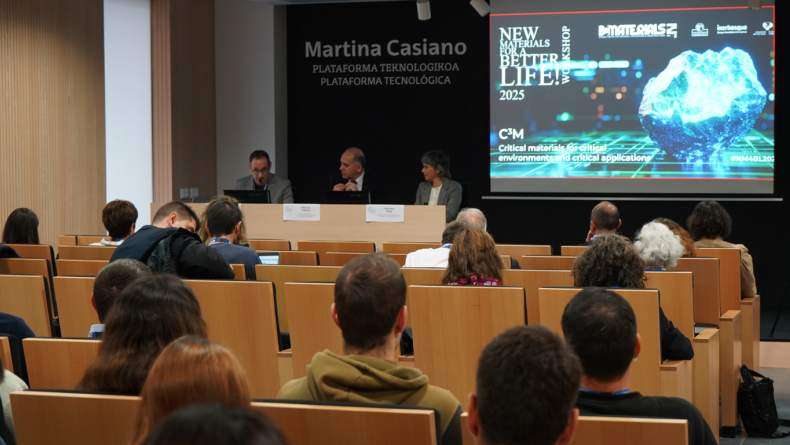BCMaterials Fortnightly Seminar #47: Iker Lamas and Lourdes Marcano

IKER LAMAS
(BCMATERIALS)
PREPARATION OF METAL AND SEMICONDUCTOR NANOSTRUCTURES FOR ENHANCEMENT OF PLASMONIC DYE-SENSITIZED SOLAR CELLS PERFORMANCE:
In the last decade, dye-sensitized solar cells (DSSCs) have received much attention because of their attractive properties although much work is required to reach optimal device efficiencies. In this Master´s Thesis different nanostructures have been synthesized in order to enhance the efficiency of DSSCs with TiO2 photoanodes. For that purpose, TiO2 nanoparticulated mesoporous xerogels have been synthesized from aqueous solution using molecular atrane complexes as precursors. Two kind of semiconductors have been synthesized, one using a surfactant-free strategy (UVM-11) and another one using it (UVM-7). Also, Ag and Au core@shell nanorods have been prepared and its coupling effects on the performance of DSSCs have been investigated by absorption and emission (fluorescence) UV-Vis-NIR spectroscopy and high temperature electrochemical impedance spectroscopy. Despite the fact that we couldn´t demonstrate if there is an energy transfer process between localized surface plasmon resonance band of NRs and conduction bands of semiconductor, we determinate that Au@Au NRs are a promising alternative to achieve a higher photocurrent and power conversion efficiency.LOURDES MARCANO
(UPV/EHU)
MAGNETIC CHARACTERIZATION OF MAGNETIC NANOPARTICLES BIOSYNTHESIZED BY MAGNETOTACTIC BACTERIA
Magnetotactic bacteria Magnetospirillum gryphiswaldense are a microorganism that can align and navigate in geomagnetic fields thanks to the presence of a chain of magnetite nanoparticles, also called magnetosomes, which play the role of a compass needle. The highly biologically control established in the synthesis of magnetosomes leads to nanoparticles with a high structural and chemical quality. Moreover, this sort of biological nanoparticles is surrounded by a 2-3 nm lipid bilayer, which protects magnetite nanoparticles from a fast oxidation, make it more biocompatible and also simplify the functionalization of the nanoparticles [1]. The narrow size distribution with a mean size of 45 nm, the well-controlled stoichiometry and the self-protection offered by the external membrane of the biosynthesized nanoparticles are some enviable properties from the point of view of physical and chemical synthesis methods. For that, in this work we take an advantage of these interesting properties to make a magnetic characterization paying specially attention in those phenomena observed in magnetite at nanoscale. Regarding to magnetic measurements, apart from the Verwey transition, a well-known transition proper to magnetite [2], other transition at lower temperatures is also observed [3]. This transition is frequency dependent and it said to be related with surface effect. However, an accurate explanation is not found anywhere. In the present work, apart from the common hysteresis loops and ZFC-FC curves, we also have performed IRM (Isothermal Remanent Magnetization) and DCD (Demagnetization Curve) measurements which give us information about the sort of interaction. And by means of relaxation measurements, we are able to determine the magnetic viscosity of our sample. An interesting evolution of the viscosity with temperature has been found. This measurements show a maximum at low temperatures, which is related with the first transition. As well as, from the magnetic viscosity and susceptibility we are able to estimate the activation volume of the particles. This parameter matches well with the particle size above the Verwey temperature; however, bellow this temperature the activation volume decreases. [1] D.A. Bazylinski and R. Frankel, Nature Reviews (2004) [2] F.Walz, J.Phys.Condes.Matter 14, R285 (2002) [3] H. Fischer, G.Mastrogiacomo, J.F.Löffler, R.J.Warthmann,P.G.Weidler and A.U.Gehring, Earth and Planetary Science Letters 270 200–208 (2008)Related news
María Calles, New Doctor of BCMaterials
We would like to congratulate María Calles García for obtaining her PhDs in Materials Science and Technology from the UPV/EHU. On December 4 made a brilliant defense of her thesis titled ‘Chelating…Invited Talk with Barcelona Microelectronics Institute’s researchers (December 3)
On December 3 at 12:00 PM, in the Martina Casiano Auditorium in Leioa, BCMaterials will host senior researchers Antón Guimerà and Xavier Illa from the Barcelona Microelectronics Institute (IMB-CNM,…Invited Talk by Liu Yao on Lithium-Metal Batteries (December 2)
Next Monday, December 2, Liu Yao, professor at the Shanghai Institute of Applied Physics, will give an invited lecture at BCMaterials entitled ‘Li-Metal Batteries: From Liquid to Solid-State’. The…Success of BCMaterials’ Annual Workshop on Critical Materials
The 2025 edition of BCMaterials’ annual workshop gathered nearly one hundred participants on November 19 in Leioa to review the latest advances and discuss critical materials, their applications, and…



